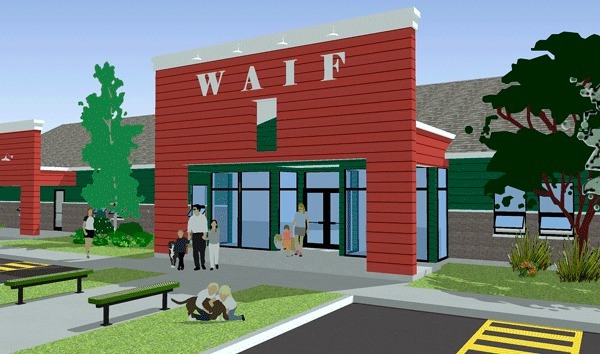A reinvigorated campaign is under way to raise $3.5 million to build a large, airy, state-of-the-art building on Whidbey Island to house homeless dogs and cats until new homes can be found for them.
Board members of Whidbey Animals’ Improvement Foundation, or WAIF, have been planning for years to replace the aging animal shelter on Highway 20 south of Coupeville.
The economic downturn put the effort on hold for a few years, but now the nonprofit organization has kick-started fundraising with a full-blown campaign, complete with a campaign office, a new website and even campaign staff.
WAIF officials worked with a national expert in animal shelter construction to design the proposed, 11,000-square-foot building, which has been approved by the Island County Planning Department.
“The main goal is the comfort and safety of the animals,” said Cliff Sanderlin, a professional fundraiser in the Seattle area. “There’s a whole new concept to modern shelters, with more light, more exercise, more conditions that are like home for the animals.”
To donate or learn more about the campaign, check out waifnewshelter.wordpress.com or call the campaign office at 360-221-0321.
The current shelter building, which wasn’t designed for the purpose, is owned by Island County and is less than ideal for keeping pets happy. It is small, located next to the county transfer station and was built on top of the former county landfill, so methane leaks are a constant source of concern.
WAIF’s open-door policy of accepting all dogs and cats has led to a consistently full shelter, which in turn leads to a high risk of disease transmission.
“The staff currently has an enormous challenge keeping pets healthy and has done an admirable job under the most difficult conditions,” WAIF’s executive director, Stephen Paysse, said.
Under the new design, the facility will allow for complete separation and quarantine of pets if needed, as well as social areas for healthy animals. It will be built to near-hospital standards for air and solid waste handling, and use surface materials that can be effectively scrubbed and disinfected, Paysse said.
Sanderlin explained that the building is designed with separate wings for cats and dogs, which studies have shown leads to less stress in the pets’ lives.
For cats, there will be kitty community rooms with fenced, outdoor “sun porches.” For the pooches, there will be runs that accommodate multiple dogs, as well as a large outdoor fenced area for play and training.
According to a WAIF press release, the new shelter will also “more efficiently provide for all of WAIF’s current programs including its spay/neuter clinic, education and training programs, and feral cat spay/neuter program. It will also facilitate expanded programs and more on-site community involvement.”
A few years ago, the nonprofit organization purchased a nine-acre piece of wooded property just across the highway, adjacent to Rhododendron Park. If all goes well, someday it will be the site of the new shelter.
WAIF was founded in 1990 by a group of animal lovers on Whidbey Island in response to the county’s handling of homeless pets. Prior to WAIF, the county was euthanizing about a thousand dogs a year and cats were euthanized without so much as a waiting period, according to Sanderlin.
WAIF contracts with the county to handle stray dogs, which is a state mandate. The group also takes in and adopts out cats. In a separate contract first adopted six years ago, WAIF works with the city of Oak Harbor to run the animal shelter on the Navy Seaplane Base. That shelter is also inadequate and WAIF, the city and the Navy are discussing moving the shelter to another building. In addition, the group runs cat adoption centers in Oak Harbor and Freeland.
WAIF runs the programs as minimum-kill shelters, which means pets are only euthanized if they suffer from fatal injuries or diseases, or have behavioral problems that make them unadoptable.
WAIF officials say Whidbey Island is “one of the three safest communities for homeless pets on the West Coast” because of the shelter’s minimum-kill policy. Sanderlin said that statistic is based on the number of pets euthanized per 1,000 people in the community.
According to Shari Bibich, WAIF shelter manager, the Coupeville facility took in 375 dogs and 306 cats in 2009. Of those, 19 dogs and 18 cats were euthanized.



